HILLS AND GREENS
Who would say a no to those mind boggling train journeys amidst the hills covered with blankets of tea estates and waterfalls. Trekking and hiking are becoming Popular over days and Translink travels helps you tick your bucket list.
Day 01 - Airport / Dambulla
Wash and rest at the hotelAfter the receiving formalities are done at the airport by our tour guides the corresponding vehicles will take you to the respective hotel and (breakfast/lunch/dinner) will be provided depending upon the time
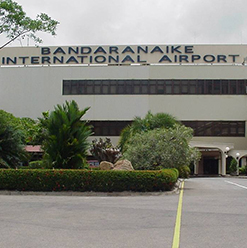

Day 01 - Airport / Dambulla
Wash and rest at the hotelAfter the receiving formalities are done at the airport by our tour guides the corresponding vehicles will take you to the respective hotel and (breakfast/lunch/dinner) will be provided depending upon the time
Day 02 - Dambulla / Sigiriya / Habarana / Dambulla
Elephant ride in HabaranaBullock Cart tour
Sigiriya Rock
Sigiriya or Sinhagiri (Lion rock )is an ancient rock fortress located in the northern Matale District near the town of Dambulla in the Central Province, Sri Lanka.
Sigiriya today is a UNESCO listed World Heritage Site. It is one of the best preserved examples of ancient urban planning
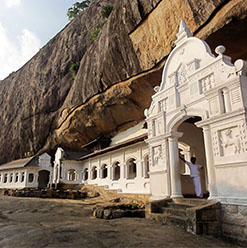

Day 02 - Dambulla / Sigiriya / Habarana / Dambulla
Elephant ride in HabaranaBullock Cart tour
Sigiriya Rock
Sigiriya or Sinhagiri (Lion rock )is an ancient rock fortress located in the northern Matale District near the town of Dambulla in the Central Province, Sri Lanka.
Sigiriya today is a UNESCO listed World Heritage Site. It is one of the best preserved examples of ancient urban planning
Day 03 - Dambulla / Matale / Kandy
Spice Garden in MataleThe Greeks, Romans and the Arabic maintained their links with Sri Lanka through the spice trade. Sri lanka has also earned the name “island of spices”.the spice garden in matale helps you identify the various kinds of spices in Sri lanka.
PM: Visit the Kandy City and Kandyan Cultural danceKandy located in the Central Province, Sri Lanka. It was the last capital of the ancient kings' era of Sri Lanka.The city lies in the midst of hills in the Kandy plateau, which crosses an area of tropical plantations, mainly tea. Kandy is the home of The Temple of the Tooth Relic (Sri Dalada Maligawa), one of the most sacred places of worship in the Buddhist world. It was declared a world heritage site by UNESCO in 1988.
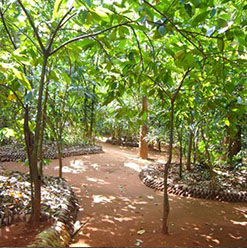

Day 03 - Dambulla / Matale / Kandy
Spice Garden in MataleThe Greeks, Romans and the Arabic maintained their links with Sri Lanka through the spice trade. Sri lanka has also earned the name “island of spices”.the spice garden in matale helps you identify the various kinds of spices in Sri lanka.
PM: Visit the Kandy City and Kandyan Cultural danceKandy located in the Central Province, Sri Lanka. It was the last capital of the ancient kings' era of Sri Lanka.The city lies in the midst of hills in the Kandy plateau, which crosses an area of tropical plantations, mainly tea. Kandy is the home of The Temple of the Tooth Relic (Sri Dalada Maligawa), one of the most sacred places of worship in the Buddhist world. It was declared a world heritage site by UNESCO in 1988.
Day 04 - Kandy
Peradeniya Botanical GardenRoyal Botanic Gardens, Peradeniya are about 5.5 km to the west of the city of Kandy in the Central Province of Sri Lanka. It attracts 2 million visitors annually. It is near the Mahaweli River (the longest in Sri Lanka). It is renowned for its collection of orchids.
There are avenues in the River Drive such as Cook's Pine Avenue, Palmyra Palm Avenue, Double Coconut Avenue, Cabbage Avenue, and Royal Palm Avenue. The classical Avenue of Palms is in this Garden. One item with a significant history is the Cannonball Tree planted by King George V of the United Kingdom and Queen Mary in 1901. It is often laden with fruit, which are thought to resemble cannonballs.
Temple of the Tooth
Temple of the Tooth relic On the north shore of the lake, which is enclosed by a parapet of white stone dating to the beginning of the 19th century, are the city's official religious monuments, including the Royal Palace and the Temple of the Tooth, known as the Dalada Maligawa (daḷadā māligāva). Reconstructed in the 18th century, the Dalanda Maligawa is built on a base of granite that was inspired by the temples of Sri Lanka's former capital city, Anuradhapura. An array of materials (limestone, marble, sculpted wood, ivory, etc.)
Gem Museum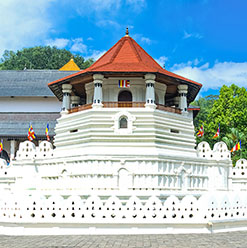

Day 04 - Kandy
There are avenues in the River Drive such as Cook's Pine Avenue, Palmyra Palm Avenue, Double Coconut Avenue, Cabbage Avenue, and Royal Palm Avenue. The classical Avenue of Palms is in this Garden. One item with a significant history is the Cannonball Tree planted by King George V of the United Kingdom and Queen Mary in 1901. It is often laden with fruit, which are thought to resemble cannonballs.
Temple of the Tooth
Temple of the Tooth relic On the north shore of the lake, which is enclosed by a parapet of white stone dating to the beginning of the 19th century, are the city's official religious monuments, including the Royal Palace and the Temple of the Tooth, known as the Dalada Maligawa (daḷadā māligāva). Reconstructed in the 18th century, the Dalanda Maligawa is built on a base of granite that was inspired by the temples of Sri Lanka's former capital city, Anuradhapura. An array of materials (limestone, marble, sculpted wood, ivory, etc.)
Gem MuseumDay 05 – Kandy / Adams’ Peak
Adams’ peakAdam's Peak also known as Sri Pada or "Sri Paadaya and Samanalakanda, "Butterfly Mountain"; Tamil: Sivanolipatha Malai; Arabic: Al-Rohun) is a 2,243 m (7,359 ft) tall conical mountain located in central Sri Lanka. It is well known for the Sri Pada, i.e., "sacred footprint", a 1.8 m (5 ft 11 in) rock formation near the summit, which in Buddhist tradition is held to be the footprint of the Buddha, in Hindu tradition that of Shiva and in Islamic and Christian tradition that of Adam, or that of St. Thomas.
It is an important pilgrimage site, especially for Buddhists. Pilgrims walk up the mountain, following a variety of difficult routes up thousands of steps. The journey takes several hours at least. The peak pilgrimage season is in April, and the goal is to be on top of the mountain at sunrise, when the distinctive shape of the mountain casts a triangular shadow on the surrounding plain and can be seen to move quickly downward as the sun rises.
Climbing at night can be a remarkable experience, with the lights of the path leading up and into the stars overhead. There are rest stops along the way.
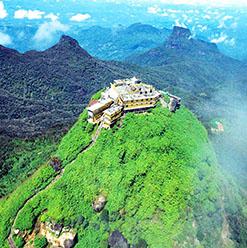

Day 05 – Kandy / Adams’ Peak
Adams’ peakAdam's Peak also known as Sri Pada or "Sri Paadaya and Samanalakanda, "Butterfly Mountain"; Tamil: Sivanolipatha Malai; Arabic: Al-Rohun) is a 2,243 m (7,359 ft) tall conical mountain located in central Sri Lanka. It is well known for the Sri Pada, i.e., "sacred footprint", a 1.8 m (5 ft 11 in) rock formation near the summit, which in Buddhist tradition is held to be the footprint of the Buddha, in Hindu tradition that of Shiva and in Islamic and Christian tradition that of Adam, or that of St. Thomas.
It is an important pilgrimage site, especially for Buddhists. Pilgrims walk up the mountain, following a variety of difficult routes up thousands of steps. The journey takes several hours at least. The peak pilgrimage season is in April, and the goal is to be on top of the mountain at sunrise, when the distinctive shape of the mountain casts a triangular shadow on the surrounding plain and can be seen to move quickly downward as the sun rises.
Climbing at night can be a remarkable experience, with the lights of the path leading up and into the stars overhead. There are rest stops along the way.
Day 06 – Adams’ Peak / Nuwara Eliya
Leisure at hotel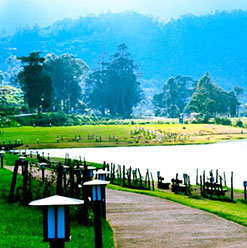

Day 06 – Adams’ Peak / Nuwara Eliya
Leisure at hotelDay 07 – Nuwara Eliya
Visit the waterfallsTea Factory and Plantation
Horton Plains National Park
Horton Plains National Park is a protected area in the central highlands of Sri Lanka and is covered by montane grassland and cloud forest.
The Horton Plains are the headwaters of three major Sri Lankan rivers, the Mahaweli, Kelani, and Walawe. In Sinhala the plains are known as Maha Eliya Plains. Stone tools dating back to Balangoda culture have been found here. The plains' vegetation is grasslands interspersed with montane forest and includes many endemic woody plants. Large herds of Sri Lankan sambar deer feature as typical mammals and the park is also an Important Bird Area with many species not only endemic to Sri Lanka but restricted to the Horton Plains. Forest dieback is one of the major threats to the park and some studies suggest that it is caused by a natural phenomenon.
The sheer precipice of World's End and Baker's Falls are among the tourist attractions of the park.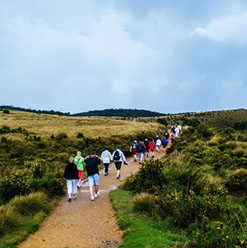

Day 07 – Nuwara Eliya
Visit the waterfallsTea Factory and Plantation
Horton Plains National Park
Horton Plains National Park is a protected area in the central highlands of Sri Lanka and is covered by montane grassland and cloud forest.
The Horton Plains are the headwaters of three major Sri Lankan rivers, the Mahaweli, Kelani, and Walawe. In Sinhala the plains are known as Maha Eliya Plains. Stone tools dating back to Balangoda culture have been found here. The plains' vegetation is grasslands interspersed with montane forest and includes many endemic woody plants. Large herds of Sri Lankan sambar deer feature as typical mammals and the park is also an Important Bird Area with many species not only endemic to Sri Lanka but restricted to the Horton Plains. Forest dieback is one of the major threats to the park and some studies suggest that it is caused by a natural phenomenon.
The sheer precipice of World's End and Baker's Falls are among the tourist attractions of the park.Day 08 – Nuwara Eliya
Ambewela FarmAmbewela is a small town, or a hill station, located in the Nuwara Eliya District of Sri Lanka. The area is also sometimes called "Little New Zealand".
The climatic and economical conditions in Ambewela make it an ideal location for dairy farming, hence the country's only milk powder factory is situated in this area. The two animal husbandries, Ambewela Farm and New Zealand Farm, have Ayrshire cattle and Friesian cows respectively.
Strawberry GardenGegory Park
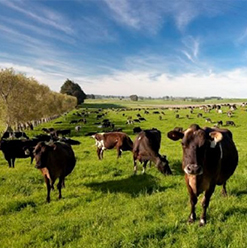

Day 08 – Nuwara Eliya
Ambewela FarmAmbewela is a small town, or a hill station, located in the Nuwara Eliya District of Sri Lanka. The area is also sometimes called "Little New Zealand".
The climatic and economical conditions in Ambewela make it an ideal location for dairy farming, hence the country's only milk powder factory is situated in this area. The two animal husbandries, Ambewela Farm and New Zealand Farm, have Ayrshire cattle and Friesian cows respectively.
Strawberry GardenGegory Park
Day 09 – Nuwara Eliya /Ella
Ella train journeyRawana Water Falls
The falls have been named after the legendary king Ravana, which is connected to the famous Indian epic, the Ramayana. According to legend, it is said that Ravana (who was the king of Sri Lanka at the time) had kidnapped princess Sita, and had hidden her in the caves behind this waterfall, now simply known as the Ravana Ella Cave. The reason for the kidnapping is said to be a revenge for slicing off the nose of his sister by Rama (husband of Sita) and his brother Laxmana. At the time, the cave was surrounded with thick forests in the midst of wilderness. It is also believed that Rama’s queen bathed in a pool that accumulated the water falling from this waterfall.They believed that Ravana has played the Ravanahatha over here.
Little Adams’ Peak
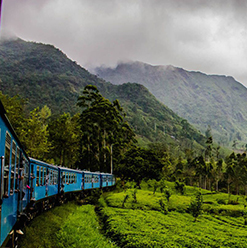

Day 09 – Nuwara Eliya /Ella
Ella train journeyRawana Water Falls
The falls have been named after the legendary king Ravana, which is connected to the famous Indian epic, the Ramayana. According to legend, it is said that Ravana (who was the king of Sri Lanka at the time) had kidnapped princess Sita, and had hidden her in the caves behind this waterfall, now simply known as the Ravana Ella Cave. The reason for the kidnapping is said to be a revenge for slicing off the nose of his sister by Rama (husband of Sita) and his brother Laxmana. At the time, the cave was surrounded with thick forests in the midst of wilderness. It is also believed that Rama’s queen bathed in a pool that accumulated the water falling from this waterfall.They believed that Ravana has played the Ravanahatha over here.
Little Adams’ Peak
Day 10 – Ella / Haputale
Lipton’s seatA sip of coffee with your favorites at the top of the mountains which provides you the best of view and is definitely going to be one best day in your life.
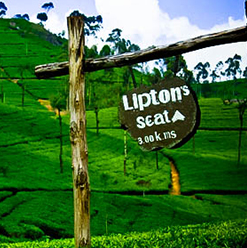

Day 10 – Ella / Haputale
Lipton’s seatA sip of coffee with your favorites at the top of the mountains which provides you the best of view and is definitely going to be one best day in your life.
Day 11 – Haputale / Yala / Udawalawe / Yala
Yala National ParkElephant Transit – Udawalawa
The Udawalawe Elephant Transfer Home is a facility within Udawalawe National Park in Sri Lanka that was established in 1995 by the Sri Lanka Department of Wildlife Conservation. Its primary objective is to rehabilitate orphaned elephant calves for ultimate release back into the wild.
The main objective of this facility is rehabilitation of orphaned baby elephants to ultimately release them back into their natural habitat. Up to three elephants per week are killed in Sri Lanka due to conflicts with humans, often leaving behind orphan calves. The elephants are kept at part of the Udawalawe National Park to maintain familiarity with their habitat, but have access to both food and medical care.
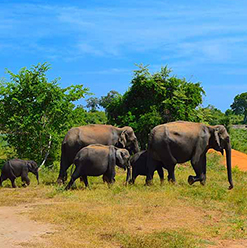

Day 11 – Ella / Haputale
Yala National ParkElephant Transit – Udawalawa
The Udawalawe Elephant Transfer Home is a facility within Udawalawe National Park in Sri Lanka that was established in 1995 by the Sri Lanka Department of Wildlife Conservation. Its primary objective is to rehabilitate orphaned elephant calves for ultimate release back into the wild.
The main objective of this facility is rehabilitation of orphaned baby elephants to ultimately release them back into their natural habitat. Up to three elephants per week are killed in Sri Lanka due to conflicts with humans, often leaving behind orphan calves. The elephants are kept at part of the Udawalawe National Park to maintain familiarity with their habitat, but have access to both food and medical care.
Map | HILLS AND GREEN
Rates Inclusive Of
Transportation on AC vehicleEnglish / Arabic speaking driver
Accommodation on mentioned basis
All taxes and service charges
Rates Not Included
Entrance ticketExtra bed and meals
Jeep
Rates Inclusive Of
Transportation on AC vehicleEnglish / Arabic speaking driver
Accommodation on mentioned basis
All taxes and service charges
Rates Not Included
Entrance ticketExtra bed and meals
Jeep
